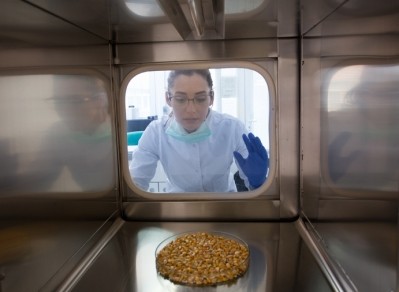reports from IPPE
Assessing soybean meal for trypsin inhibitors

We caught up with Juxing Chen, manager of structure and function biology, Novus International Inc, to hear more about her work evaluating the potential for variation in trypsin inhibitors (TI) and urease activity (UA) levels in soy products globally and the understanding of whether or not a correlation exists between TI and UA.
She presented details of her research at the International Production and Processing Expo (IPPE) in Atlanta earlier this month. However, more information about the analysis is about to be published, she told us.
“Urease activity is very easy to measure you just measure the pH... But trypsin inhibitor is very hard to measure because it requires multiple pieces of equipment and a variety of reagents with long and complicated reaction process,” she said of why there was interest in correlating the two measurements.
The steps and time involved in measuring TI mean that the process is impractical to complete during production at a processing facility, she added. Both trypsin inhibitor and urease are heat labile and inactivated by heat treatment – trypsin inhibitor content and urease activity indicate whether heat treatment during soybean meal processing is sufficient or not.
High trypsin inhibitor and high urease activity indicate under-processed soybean meal, she said. “That’s why there was interest in correlating the two measurements. But whether the two measurements were correlated to each other remains to be further investigated.”
However, the level of trypsin inhibitors in a soybean meal or similar feed ingredient is of interest to livestock and feed producers because it can reduce an animal’s ability to digest protein in the feed, she said.
“If it has high trypsin inhibitor, then the protein digestibility will be lower for the animal."
“The problem is there are very few labs in the world that measure trypsin inhibitors and also the lab to lab variation is hard to eliminate or compare,” Chen said of why her team examined the potential relation between UA and TI.
“There was a report that said they were correlated from a small set of samples, and we wanted to validate if they are truly correlated and if people can really use urease activity as a surrogate indicator of trypsin inhibitor contents,” she said.
Research overview
For the analysis, 414 samples of soybean meal were collected from 19 countries in five different parts of the world, Chen said. Samples were checked for TI and UA levels and the data split by country and region.
The research team found that the level of trypsin inhibitors ranged from 2mg to 6mg per gram and about 80% of the samples had levels of 3mg to 5mg per gram, she said. For the urease activity, amounts detected varied from 0.01 to 0.2 pH unit.
Among the countries examined, samples from Germany had the highest levels of trypsin inhibitor, she said. Samples from India had the most urease activity.
South Africa saw soybean meal samples that were high in both areas, said Chen. Regionally, samples from Africa were similar, displaying larger amounts of trypsin inhibitors and urease activity.
However, samples tested that came from Asia and North America tended to be lower in TI, she said. Urease activity was reduced in samples from Latin America and Europe.
“We performed the correlation analysis between trypsin inhibitors and urease activity in the over 400 samples measured,” Chen said. “We did not see a correlation, which means that we really cannot use urease activity as a surrogate indicator for trypsin inhibitor levels in soybean meal.”
The larger sample size used in the analysis may be one reason behind the finding, she said. Past research could have used smaller numbers of trials or locations to analyze the correlation and conclude that TI was correlated to UA.
“The different world areas or different countries may have different sorts of soybean meal samples and the processing conditions might be slightly different,” she said. “We have a larger sample size from different world areas and we feel comfortable saying that they’re not really correlated to each other, so, in our opinion, we shouldn’t just use urease activity to predict the levels of trypsin inhibitor in soybean meal samples.”
Addressing trypsin inhibitor levels
Although it remains challenging to test for levels of trypsin inhibitors in soybean product, the practice is recommended, said Chen. Novus has a lab at its headquarters in the US that runs the test and has worked with labs in Brazil and Southeast Asia to expand the geographic range of testing options for producers.
In addition to assessing soybean feed ingredients for levels of UA and TI, some research also has been done evaluating the influence of feeds with higher levels of trypsin inhibitors in poultry and swine, she said.
Both species can see a reduction in amino acids digestibility when higher levels of trypsin inhibitors are present in a diet, she said. The result tends to be more pronounced in swine, however, animal performance may not vary greatly.
"When broilers were fed a diet with high levels of trypsin inhibitor, amino acid digestion was reduced, and the birds were trying very hard to secrete enzymes to digest protein in the digesta, so their pancreas became larger, which is called pancreatic hypertrophy,” Chen said.
“We found that when the soybean meal had higher trypsin inhibitors if we add a protease to the diet, it brings amino acid digestibility up, reduces pancreatic hypertrophy and makes the performance better,” she added.















